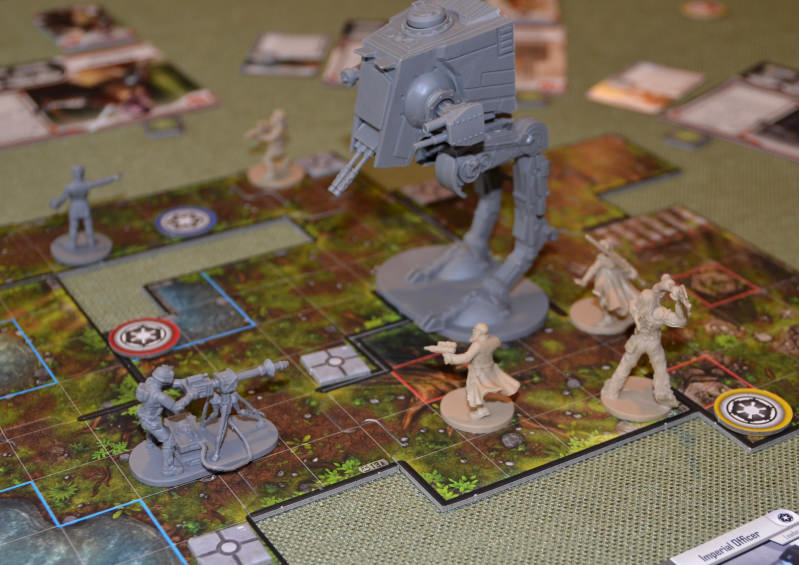Super Dungeon Explore: Forgotten King board game review

Are you up for a dungeon-explore board game that’s less about exploring and more about just battling the monsters?
If so, then Super Dungeon Explore: Forgotten King is the type of game for you!
Super Dungeon Explore: Forgotten King is a follow-up game to the original Super Dungeon Explore by Soda Pop Miniatures, Ninja Division. At first glance, you may look at the game as a expansion. But although the game does expand upon the original, it’s a standalone game in and of itself.
Which means that you don’t need to have the original to enjoy Forgotten King.
And that makes it perfect for us to review because we’ve never played the original.
Thus, our review provides a fresh perspective from first-time Super Dungeon Explore players.
How to Play Super Dungeon Explore: Forgotten King

One of the things we like most about Super Dungeon Explore: Forgotten King is that there are two ways to play the game. There is Classic Mode – which pits one person, as the Dark Consul (monster leader) against the rest, as questing Heroes. And there is Arcade Mode – where the role of Dark Consul is automated through use of unique monster cards and all the players are Heroes.
Which is our favorite way to play? Arcade Mode!
Because that means I get to play on the same team as my boys instead of having them gang up on me yet again. For me it’s a very refreshing way to play.
Like with many dungeon-crawl type board games, the first thing to keep in mind is that there’s a lot to learn.

While having played a dungeon-crawl game before can be of help, every game has slightly different mechanics. So before beginning, players need to familiarize themselves with a lot of rules.
The good thing to know is that once you understand the rules, the game can be a lot of fun.
Which is also probably why Ninja Division includes a Quick Start Rules booklet to be able to dive into game play more quickly – which is very nice.
The game comes with 4 different rulebooks: Quick Start Rules, Classic Mode, Arcade Mode, and the Explorer’s Handbook.
We’re glad Classic and Arcade Mode each have their own rulebook rather than all combined into one. Because we’ve found ourselves referring back to the rulebook a number of times, and having them separated makes finding what we’re after much easier.
Rather than go through all the rules, we’ll just give a short overview of the two different modes of game play. Starting with our favorite mode…
ARCADE MODE
The objective in Arcade Mode is to destroy all of the monster spawning points in the dungeon in order to summon and defeat the dungeon boss. The heroes lose if the Dark Consul destroys them all.

Arcade Mode is designed for 1-5 players. Which means that you and a whole group of friends can adventure together or you can take on the dungeon all by yourself. Having the dungeon boss and his minions automated makes a single-player game possible.
As I mentioned at the start, although Super Dungeon Explore: Forgotten King has “explore” in the title, the game is less about exploring and more about battling. There is an Explore deck of cards that brings in unique elements to the game, but the fun of the game is really all about the battles.
The Arcade Mode rulebook is 42 pages long. So I definitely won’t cover most of the details. The good thing to note is that the back of the rulebook is a Reference page that covers all the main points of game turns. When leaning how to play, having this easy-to-access back page nearby is a must.
Set Up
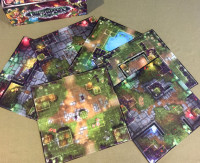
Setting up the game is very straight-forward. It takes 5 pages of the rulebook only because there are plenty of good example visuals. Players select the Heroes in the party, select the Monsters (one dungeon boss, at least two mini-bosses, spawning point models, and Creeps (minor monsters)), and Build the Dungeon.
The Dungeon consists of 1 dungeon tile for every Hero in the party. As you can see in the photos, the dungeon tiles are large singular map pieces that just sit next to each other (rather than uniquely shaped smaller map tiles that interlock like in Descent or Star Wars: Imperial Assault). The map tiles each have a grid of squares for movement and are full of walls, doorways and tile effects.
Players then build a Treasure deck, Loot deck, Explore deck, and Command deck before entering the dungeon. Once they’ve placed their heroes at a starting point, they populate the dungeon with monster figures. Each map tile has a symbol to indicate where a Spawning Point is. Every spawning point then spawns monsters and the game begins.
Heroes Activate

A unique aspect of the Heroes turn in Super Dungeon Explore is that only 2 heroes will activate each turn. First players choose one hero that didn’t activate on the prior turn, and then they choose one of the remaining heroes.
This unique element alone requires players to coordinate their turns wisely to make the most of their adventure.
Each Hero card is full of information, including values for Strength, Armor, Willpower, Dexterity as well as information on their special abilities. In the upper right corner, you’ll also notice that the symbols for Movement Points and Action Points look like video game controller buttons. It’s a nice touch that makes it easy to remember what those numbers mean.
During a hero’s activation they can move their figure up to their Movement Points to adjacent spaces. They can also allocate their Action Points among a variety of options such as different types of attacks (red button icons) and different types of support actions (blue button icons). Players can also split up their use of movement and action points during their turn as long as they don’t exceed the total. For example, they can move a few spaces, perform and action, move more spaces, and perform another action.

The cost in action points of a particular action is indicated on the action button icon of the action they want to perform.
As an example, note in the photo of the hero cards that the Thundervale Huntress can spend 2 action points to use the Lightning Charge. The Lightning Charge is a Melee Attack with a range of 2 spaces, grants an additional red die in the dice pool to roll, and can Push the target away up to 5 spaces.
Each hero’s card also shows how many and which color of dice to roll for each attribute. So with the same example above, for a roll using Strength (as in an attack) the Thundervale Huntress will normally roll 2 blue dice and 1 red die. As they gain equipment and potions, heroes will get to add more dice to their dice pool.
The Dice

Heroes roll dice for almost everything they do. There are blue, red, and green dice – with green being the best.
Star symbol: Determines the outcome of an attack. The total Star results from the attacker is compared to the star results from the defender. If the attacker rolls more Stars than the defender, the attacker wins. If there is an equal amount of Stars or the defender rolls more Stars, the defender wins.
If the action used was a Red action, the winner will inflict 1 wound on the target.
During Arcade Mode, monsters only have attribute Stars on their cards so they don’t actually roll any dice for battles, players just compare their rolls to the stars on the monster card.
Heart symbol: If an offense roll wins and any hearts were rolled, a hero can remove one wound token or one status effect from any Hero’s game card for each heart rolled.
Potion symbol: If an offense roll winds and any potions were rolled, a hero can place a potion token on any hero’s game card for each potion rolled.
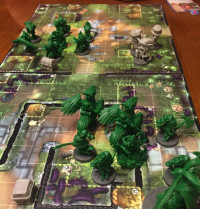
As with most dungeon-crawl type games, when attacking, players need to first determine Line of Sight. The way line of sight works in Super Dungeon Explore is simple. A figure has line of sight when it can trace at least one straight line from any point of its square to any point on the target’s square/s. The line can’t contact walls or structures. Other figures (friend or enemy) don’t block line of sight.
Attacks
There are 3 basic types of attacks and each are dependent on the abilities of the character as indicated on their card. Magic attacks use the Willpower attribute. Melee attacks use the Strength attribute. And Missile attacks use the Dexterity attribute.
Support
While monsters may only use the Run and Vigor support action, in addition to those Heroes have many more they can benefit from, including: Bandage, Conjure Pet, Disarm Trap, Explore, Pick Lock, Scavenge, Smash Chest, and Unlock Treasure Chest.
In addition to movement and actions, Heroes can also use potions they’ve collected for special, single-use actions. These actions require different amounts of potion tokens to use. But they can be very helpful in times of need.
As you can see, there are plenty of options a player has to take each activation. And it’s the combinations of character abilities and action options that opens up a rich gaming experience.
But that’s not all there is to a game round. There’s still the Dark Consul’s turn…
Monsters Activate

After the Heroes have activated, the monsters take their turns. And it’s in this stage where the beauty of Arcade Mode kicks in.
Most of the events that happen during the Monster activation are determined by drawing a card from the Command Deck. There are a few game effects that throw in a few twists, but we’ll skip talking about those. Instead we’ll focus on how cool the Command Deck makes the game.

There are a variety of monsters in Super Dungeon Explore: Forgotten King that either operate as Solo monsters or as Gangs. Gangs are a group of monsters that rally together around an Elite monster. Minion monsters are bonded to an Elite monster and in an of themselves cannot take actions. Instead they lend support to the Elite – which essentially means that it’s tougher to get to and beat the Elite because of the swarm of minions around it.
Minions are also expendable. This means that as an Elite takes wounds, the wound token goes to the closest bonded minion. Only when no bonded minions are within two squares will the Elite suffer the wound.
Order of Monster Activation
Monsters activate only when they’re Disturbed. Of course it’s not to tough to Disturb monsters. At the start of the Dark Consul turn, any monster on a tile with Heroes or a on a map tile that shares a doorway to a tile with Heroes is Disturbed.
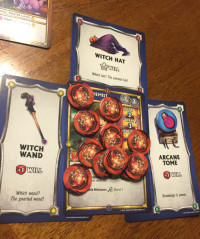
Since in Arcade Mode the monsters are automated, Disturbed monsters activate in a set order: Creep, Dungeon Boss, Mini-Boss, Elite, Minion. They also begin with the monster of the given type that is closest to the Hero with the most Wrath.
Incurring Wrath
As Heroes go about doing their thing, they incur Wrath. The amount of Wrath they accumulate depends on what amazing feats they accomplish on their turn (like destroying monsters, drinking potions, opening chests, or destroying spawn points).
So when it comes time for monsters to attack, the Hero with the most Wrath determines which monsters go first (and may also determine who they head for).
Command Cards
A player draws a Command card from the deck which determines what the activated monsters will do this turn. Using the order of activation, monsters perform each command listed on the card in they order they are listed.

For example, the Hack & Slash card says “Move x1, Fight x1”. So each monster will take those actions. The most common commands are: Spawn, Move, Unique, and Fight.
Rather than go into details of each, let’s just say they’re all meant to come after the Heroes with a vengeance. For example, you could correctly guess that Spawn means more monsters are arriving on the scene.
We’ll let you know that for the Move action, dungeon bosses, mini-bosses, and elite monsters will always move towards the Hero with the most Wrath. Knowing this means that Heroes can use it to their advantage.
For example, you can have a hero incur a lot of Wrath and then lure the monsters to where you want them.
After all monsters of a given type have activated, it moves onto the next monster type (again beginning with the monster of that type closest to the Hero with the most Wrath).

If a figure suffers wounds equal to their Health (heart symbol on their card), they are destroyed.
If it’s a Monster, the figure is removed from the board and returned to the spawning pool. If it’s a Hero, the figure is removed from the board and a skull token is placed in the square where it perished.
Any other Hero can retrieve a skull token and place the perished hero’s equipment in the Backpack (where other Heroes can then equip it at the end of the round).
Power Up

At the end of the Hero turn as well as the Monster turn, there is a Power-Up stage. There are 4 types of Power-Up.
Equipment: This is where heroes get more special abilities to defeat the monsters. And it’s a lot of fun to equip heroes throughout the game.
The party may draw 1 card from the Loot Deck for every Elite of minion monster destroyed that turn (up to max of 3). The party may draw 1 card from the Treasure Deck for each mini-boss or boo booty destroyed. Heroes can decide who gets which cards to add to their character.
Hero cards have colored dots on each side of the card and all the equipment cards also have corresponding colors. To add equipment, a Hero places the equipment card on the appropriate side of its card to use that ability. For example, the Weapons are yellow and are placed on the left side of a hero card.

Each equipment card that isn’t used is discarded and a Hero may remove a wound or status effect token. And heroes can switch out their equipment as they get better gear along the way.
Wonder: Heroes may equip or use wonders they’ve collected. And each wonder has its own unique effects as well.
Mighty Monsters: After a turn in which a mini-boss was destroyed, the Mighty Monster chart advances one step and get additional Strength and/or Armor based on how many mini-bosses have been destroyed. Once the top of the chart is reached, the monsters are now extra mighty.
Boss Spawn: For every spawning point that was destroyed during the turn, a mini-boss is placed on the map in that spawning spot. If the spawning point was the last one in the dungeon, the Dungeon Boss is spawned instead.
The game continues through Hero and Monster activations until one of the sides win. Either the Dungeon Boss is defeated or all the Heroes are destroyed.
Whew. That’s a lot of things to cover even in our simplified overview of the game.
Like we said, it’s a lot to take in on the first and second play. But once you get the hang of it, it can be a lot of fun.
CLASSIC MODE

The other way to play Super Dungeon Explore: Forgotten King is via Classic Mode. This section won’t take as long because the basic game play is pretty much the same as what we’ve described in Arcade Mode.
The major difference between the two modes of play is that in Classic Mode, one player plays the role of the Dark Consul. Instead of having the Monster Activation run automatically through a Command Deck, that player gets to allocate points to which monsters will activate each turn.
Since a player now controls the monsters, there is a second set of monster cards to be used in Classic Mode. Instead of having Stars for their attributes, the cards indicate which dice to roll (such as for attacks and defense).
Hero Activation
The main difference during the Hero Activation stage in Classic Mode is that only 1 Hero can activate each turn. And every Hero must activate before a Hero may be activated again. Once each has activated, they can be activated again in any order.
Monster Activation

During the Monster activation, the Consul player can either Activate monsters or Spawn monsters.
The number of monsters that can be activated is determined by Skull points. Each monster is worth a number of Skull points and the Consul player can activate a total of 4 Skull points on a turn.
In addition to that, the Consul can activate one Super monster for free.
Monsters can be activated in any order but must complete their activation before another monster activates. And monsters aren’t restricted on subsequent turns. Meaning the same monster can be activated for 2 or more consecutive turns. (It just can’t be activated twice on the same turn.)
Spawning monsters is similar to the Arcade Mode and has its own set of rules that we won’t dive into here. Just remember that it means more baddies are going to infest the dungeon.
Power-Up
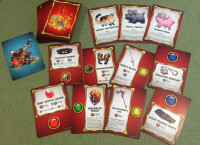
The Power-Up stages in Classic Mode are just like they are in Arcade Mode. The only difference is that when a Boss Spawns due to destroyed spawning points on that turn, the Consul player can choose any square on that dungeon tile to place the mini-boss or Dungeon Boss.
Boss Fight
The Boss Fight is a additional element in Classic Mode.
Every dungeon boss includes a Boss Fight card, listing unique rules that affect the game once the dungeon boss has spawned.
Immediately after the dungeon boss suffers a number of wound tokens equal to or greater than half its health, a Timeout is triggered. It also the dungeon boss to regroup – allowing it to remove status effects, summon more monsters, and attack from a new angle.
The attack from a new angle is powerful because it allows the boss to move to any square within 10 spaces of its current location.
A Timeout is only triggered once. So if he heals and then suffers wounds that force it past the half point of its health again, the Timeout doesn’t occur again.
Just like in the Arcade Mode, play continues between Heroes and Monsters until either the Dungeon Boss is defeated or all the Heroes are destroyed.
What we like about Super Dungeon Explore: Forgotten King
As we’ve indicated before, our favorite part of Super Dungeon Explore: Forgotten King is the Arcade Mode. It’s not that we don’t enjoy the Classic Mode as well, but it’s pretty fun all being on the same team. And since we like cooperative board games, it’s a hit with us.

While the automated monster activation at times may seem a little silly in what the monster team will do, we get a kick out of messing with them. For example, we love having the player with the most Wrath tokens lead monsters around the dungeon while the others sneak in behind.
Another element we like in both modes is the limitation of only activating certain heroes each turn. It creates a more fluid game play experience between Heroes and Monsters. Rather than having all heroes take turns, followed by all monsters, it’s a fun balance of back and forth action.
And of course, we love the miniatures!
There are a number of games that have very cool monster and hero figures, but we’re not aware of any games that have miniature pets! Who would have thought taking a dog, cat, chicken, pig, or goat on an adventure through a dungeon would be worthwhile? But it adds a lot of silly fun!
How does Super Dungeon Explore: Forgotten King score on our “Let’s Play Again” game meter?
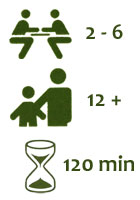 The first time we played Super Dungeon Explore: Forgotten King, Caleb was the first to call out, “let’s play again.” Unfortunately that first game had taken so long to learn, that we couldn’t play again.
The first time we played Super Dungeon Explore: Forgotten King, Caleb was the first to call out, “let’s play again.” Unfortunately that first game had taken so long to learn, that we couldn’t play again.
And that’s been the way it has gone most times we’ve played – only getting in one play each time.
Super Dungeon Explore: Forgotten King is a game to play when you’ve got a longer chunk of time carved out to play. It will take a bit of time to set up and get rolling. But once you get in the flow, the time seems to go by quickly.
Thank you Soda Pop Miniatures, Ninja Division for a fun dungeon and monster-battling game!

